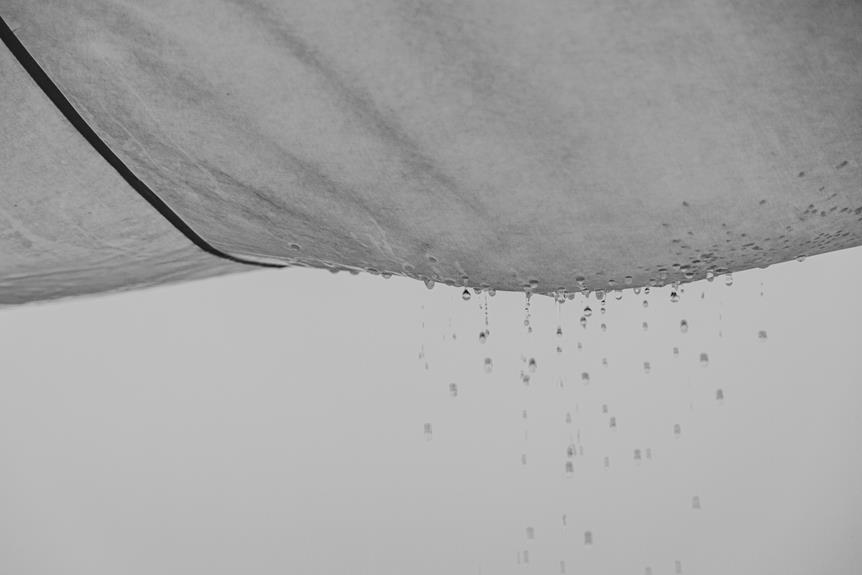Curious about whether linen fabric can stand up to water?
In this exploration of linen's moisture resistance, you'll delve into the natural properties of linen, compare its performance to other fabrics, and discover how it handles water in various environments.
From testing its water repellency to discussing practical tips for caring for linen in wet conditions, you'll gain a deeper understanding of linen's ability to resist moisture.
So, grab a cup of tea, settle in, and let's unravel the science behind linen's relationship with water.
Key Takeaways
- Linen's natural fibers are highly absorbent and can wick moisture away from the body.
- Linen possesses both water repellency and moisture absorption properties.
- Linen fabric's breathability allows for air flow and heat dissipation.
- Linen offers better moisture resistance than cotton due to its fiber structure and breathability.
The Science of Linen's Moisture Resistance
How effectively does linen fabric repel moisture?
Linen is renowned for its exceptional moisture management properties due to its unique fabric composition. The natural fibers of linen are highly absorbent and can rapidly wick moisture away from the body, making it a desirable choice for warm-weather clothing. The structure of linen fibers allows air to circulate easily, aiding in the evaporation of moisture and keeping the wearer cool and dry.
The fabric composition of linen plays a crucial role in its moisture resistance. The individual fibers have a hollow core, which contributes to its high absorbency and ability to release moisture quickly. This feature sets linen apart from other materials and makes it an excellent option for humid or sweaty conditions. Additionally, linen is also known for its antimicrobial properties, inhibiting the growth of odor-causing bacteria often associated with moisture.
Understanding the science behind linen's moisture management can help you make informed decisions when selecting clothing for various activities and climates. Whether it's for everyday wear or outdoor adventures, the moisture resistance of linen makes it a top choice for those seeking comfort and functionality.
Natural Properties of Linen Fabric
Linen fabric has some remarkable natural properties that make it a popular choice for various uses. Its water absorption capability allows it to efficiently wick away moisture, making it a breathable and comfortable fabric to wear.
Additionally, linen's resistance to mildew sets it apart as a durable and low-maintenance material.
Linen's Water Absorption
When considering linen's water absorption, it's important to understand its natural properties and how they affect its ability to handle moisture.
Linen fabric possesses both water repellency and moisture absorption properties, which may seem contradictory at first. The natural wax content in linen fibers provides a degree of water repellency, causing water to form droplets on the fabric's surface rather than being immediately absorbed. This attribute allows linen to resist moisture and dry quickly.
Simultaneously, linen fibers can absorb a significant amount of moisture without feeling damp, making it highly breathable and comfortable to wear in warm weather. These inherent properties make linen an excellent choice for garments and home textiles, as it can effectively manage moisture while offering comfort and durability.
Understanding linen's water absorption characteristics can help you appreciate its suitability for various applications.
Breathability and Moisture-Wicking
To understand the natural properties of linen fabric that contribute to its breathability and moisture-wicking capabilities, consider its unique ability to manage moisture while providing comfort and durability.
Linen's fabric breathability is exceptional due to its structure, which allows air to flow through and heat to dissipate, keeping you cool and dry.
This moisture-wicking ability is further enhanced by the fabric's natural moisture management properties, which help it absorb perspiration while quickly drying, preventing that uncomfortable clammy feeling.
The fabric properties of linen make it an excellent choice for clothing and home textiles, especially in warm or humid climates.
Its breathability and moisture-wicking features not only provide comfort but also contribute to the overall durability of the fabric.
Understanding these natural properties can help you make informed decisions when choosing linen for your needs.
Resistance to Mildew
You can rely on linen fabric's natural mildew resistance, making it suitable for damp environments. Linen's ability to prevent mildew growth is one of its exceptional natural properties. Here's how linen fabric maintains its moisture resistance:
- Natural antimicrobial properties: Linen contains natural antimicrobial compounds that inhibit the growth of mildew and mold, making it an excellent choice for humid climates.
- Breathability: Linen's breathability allows moisture to evaporate quickly, preventing damp conditions that can lead to mildew.
- Easy maintenance: Regular cleaning and proper air circulation help maintain linen fabric's moisture resistance, ensuring it remains mildew-free.
- Storage tips: Store linen items in well-ventilated areas and avoid damp, dark spaces to prevent mildew growth.
Linen's inherent resistance to mildew makes it a durable and reliable choice for various applications.
Comparing Linen to Other Fabrics
So, you're probably wondering how linen stacks up against other fabrics when it comes to handling moisture.
Well, let's compare it to cotton in terms of moisture absorption and synthetic fabrics in terms of moisture resistance.
Understanding how linen performs in comparison to these popular materials will give you a clearer picture of its moisture-handling capabilities.
Linen Vs. Cotton Moisture
When comparing linen to cotton, it offers better moisture resistance. Linen's superior moisture-wicking properties make it a standout choice when compared to cotton. Here's why linen outperforms cotton in moisture resistance:
- Fiber Structure: Linen fibers are hollow and more absorbent than cotton, allowing for better moisture evaporation.
- Breathability: Linen fabric allows air to flow more freely, aiding in the evaporation of moisture.
- Durability: Linen can absorb up to 20% of its weight in moisture before feeling damp, while cotton can only absorb 15%.
- Thermo-Regulating Properties: Linen's ability to quickly absorb and release moisture helps in keeping the body cool and dry.
These factors make linen a top choice over cotton when it comes to moisture resistance and overall comfort.
Linen Vs. Synthetic Absorption
Comparing linen to synthetic fabrics in terms of moisture absorption, linen outperforms due to its natural properties and construction.
Linen is highly breathable and has the ability to absorb moisture while still feeling dry to the touch.
In contrast, synthetic fabrics, such as polyester and nylon, aren't as effective in managing moisture due to their non-absorbent nature.
Linen's natural fibers have irregular structures that create gaps, allowing for better airflow and moisture absorption.
This natural vs. synthetic moisture management makes linen a preferred choice, especially in warm and humid conditions.
Additionally, linen's characteristics, including its ability to wick moisture away from the body and its quick-drying properties, further highlight its superiority over synthetic fabrics when it comes to moisture absorption.
Testing Linen's Water Repellency
To determine linen's water repellency, you can conduct a simple water droplet test on the fabric's surface. This will help you gauge how well the fabric resists water and whether it has any moisture-repellent properties. Here's how you can test linen's water repellency:
- Water Droplet Test: Place a few droplets of water on the surface of the linen fabric and observe how the water behaves. If the water beads up and rolls off the fabric without being absorbed, it indicates good water repellency.
- Absorption Rate: Time how long it takes for the water droplets to be absorbed into the fabric. The quicker the absorption, the lower the water repellency.
- Visual Inspection: After the water droplet test, visually inspect the fabric for any signs of water penetration or dampness. This will give you a clear indication of the fabric's ability to resist moisture.
- Repeat Testing: Perform the water droplet test in multiple areas of the fabric to ensure uniform water repellency throughout the material.
Conducting these tests will provide valuable insights into the water repellency of linen fabric, aiding in moisture resistance analysis.
Linen's Performance in Water-Prone Environments
If you find yourself in water-prone environments, linen fabric can demonstrate its moisture resistance effectively. Linen's performance in outdoor activities or water-prone environments showcases its durability and functionality. Whether you're engaging in water sports, hiking in damp conditions, or simply caught in the rain, the moisture resistance of linen makes it a practical choice for both fashion and function.
| Outdoor Activities | Durability |
|---|---|
| Water sports | Excellent |
| Hiking | Reliable |
| Rainy weather | Resilient |
| Camping | Sturdy |
Linen's ability to repel moisture while maintaining its structural integrity makes it suitable for a range of outdoor activities. Its durability ensures that it can withstand the rigors of outdoor adventures, making it a dependable choice for those who seek both style and performance. Whether it's in the form of clothing, bags, or other accessories, linen's performance in water-prone environments makes it a practical and reliable option for those who value both fashion and functionality.
Enhancing Linen's Water Resistance
To enhance linen's water resistance, consider treating the fabric with a waterproofing agent during the manufacturing process. This can help improve the fabric's ability to repel water and increase its durability in water-prone environments.
Here are some methods for enhancing linen's water resistance:
- Nano-coating Technology: Utilize advanced nano-coating technology to create a protective layer on the linen fabric, making it highly water-resistant without compromising its breathability.
- Natural Wax Treatment: Apply natural wax, such as beeswax or vegetable wax, to the linen fibers to enhance their natural water resistance and provide a sustainable waterproof coating.
- Eco-friendly DWR Finishes: Explore environmentally friendly durable water repellent (DWR) finishes that are designed to bond with the linen fibers, creating a long-lasting water-resistant barrier.
- Laminating Techniques: Implement laminating techniques that involve bonding a thin waterproof membrane to the linen fabric, enhancing its ability to withstand moisture while maintaining its natural feel and breathability.
Caring for Linen in Wet Conditions
In wet conditions, properly drying linen fabric after exposure to water is crucial to maintain its quality and integrity. When caring for linen in wet conditions, it's important to employ effective drying techniques. After washing or getting wet, gently squeeze out excess water from the fabric and then lay it flat to air dry. Avoid wringing out the linen, as this can cause wrinkling and misshaping. If using a clothesline, support the entire length of the linen garment to prevent stretching. Additionally, avoid direct sunlight, as it can cause fading and weaken the fibers.
For added protection in wet conditions, consider applying waterproof coatings to your linen items. There are various waterproofing products available that can be sprayed or brushed onto the fabric to enhance its water resistance. Always follow the manufacturer's instructions when applying these coatings. Keep in mind that waterproof coatings may alter the texture and breathability of the linen, so it's essential to balance the level of water resistance with the fabric's natural characteristics.
The Practicality of Linen for Water Exposure
Linen fabric demonstrates practicality for water exposure due to its natural moisture-wicking properties and durability. When considering the practicality of linen for water exposure, several key factors come into play.
- Durability: Linen is known for its strength and durability, making it an excellent choice for outdoor activities and environments where exposure to water is likely. Its sturdy nature allows it to withstand frequent use and exposure to moisture without deteriorating quickly.
- Moisture-Wicking Properties: Linen has the ability to absorb moisture while still feeling dry to the touch, making it ideal for activities involving water exposure. This feature ensures that the fabric remains comfortable and breathable, even when it comes into contact with water.
- Quick Drying: Linen has a natural tendency to dry quickly, which is advantageous for fabric maintenance after water exposure. This quick-drying characteristic reduces the likelihood of mold and mildew growth, making linen a practical choice for water-related activities.
- Versatility: Linen's practicality for water exposure extends beyond clothing to other items such as towels, picnic blankets, and outdoor upholstery. Its versatility makes it a valuable choice for various outdoor and water-related applications.
Frequently Asked Questions
Can Linen Fabric Be Used for Swimwear or Other Water Sports Clothing?
Yes, linen fabric has good moisture resistance, making it suitable for water sports clothing like swimwear. Its natural properties allow it to handle water well, providing comfort and breathability for your aquatic activities.
Is Linen Fabric Suitable for Outdoor Furniture and Cushions That May Be Exposed to Rain or Moisture?
Yes, linen fabric is suitable for outdoor furniture and cushions. Its outdoor durability makes it a great choice, and its moisture management abilities allow it to withstand exposure to rain or moisture without compromising its quality.
Can Linen Clothing Be Worn in Humid or Rainy Climates Without Becoming Waterlogged?
Linen fabric durability and breathability make it suitable for humid or rainy climates. It can handle moisture without becoming waterlogged, making linen clothing a great choice for such conditions. You'll stay comfortable and stylish.
How Does Linen Fabric Hold up in Terms of Water Resistance Compared to Synthetic Fabrics Like Polyester or Nylon?
Linen fabric has good moisture absorption, performing well in humid or rainy climates. Compared to synthetic fabrics like polyester or nylon, linen's natural fibers offer comparable water resistance. It's a great choice for staying comfortable in wet conditions.
Are There Any Special Treatments or Coatings That Can Be Applied to Linen Fabric to Improve Its Water Resistance?
To improve linen fabric's water resistance, you can apply special treatments or coatings. These can help repel water and protect the fabric. Look for products specifically designed for linen to maintain its natural look and feel while enhancing its moisture resistance.
- Tetron Fabric for Marine Applications: Durability and Use Cases - June 18, 2025
- Tetron Fabric for Outdoor Furniture: Weather Resistance and Care - June 18, 2025
- Tetron Fabric for Wall Coverings: Style and Application Tips - June 18, 2025






